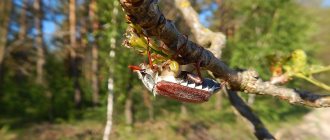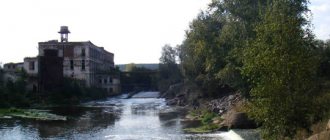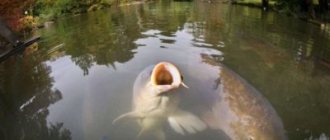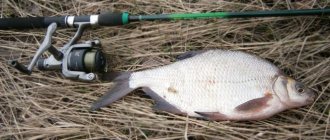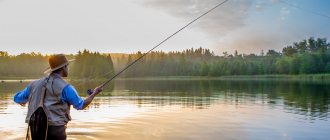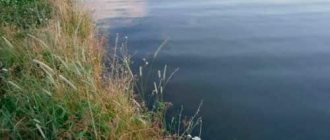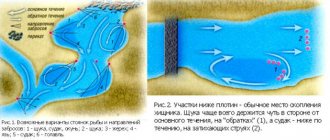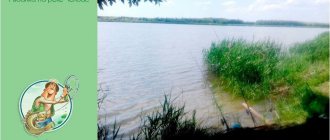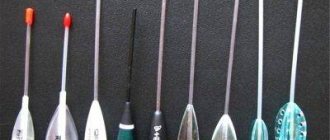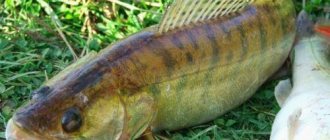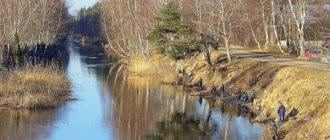There are countless insects in nature, a significant part of which in one or another phase of development can be used as a good bait for fishing. This review includes only some types of insects that have been tested as bait by the experience of many fishermen and are found in large numbers on the territory of Ukraine.
In addition to the names of insects, it is useful for a fisherman to get acquainted with their biological nature, with the development of the insect throughout the entire life cycle. This will allow you to know the time and methods of harvesting and using not only the species described in the review, but also other insects useful for fishing. After completion of development in the egg, i.e. the embryonic phase, hatching occurs; from this moment, the insect enters the second stage of its development - the larval phase, from which the post-embryonic, or post-embryonic, period begins. In this phase of development, the growth of the larvae is accompanied by periodic molting - shedding of the old skin. The next phase of the larval transformation is the adult phase, called the adult. There are insects with incomplete metamorphosis (Hemimetabola) and complete (Holometabola).
In the first case, the transition to an adult insect occurs directly from the larva with the last molt; in the second case, through a special intermediate phase of development - the pupa. In accordance with this, the former are characterized by three, and the latter by four phases of development. The number of periodic molts during the growth of the larvae varies among different groups and species of insects, varying from 3 (flies) to 4-6 (locusts, butterflies) and even up to 45 (mayflies). The adult insect, the imago, is the final phase of the life cycle. But the transition to this phase does not always complete the development (to a sexually mature state) of the individual.
The life cycle takes different times for different types of insects. Some species have one generation per year, others - 2-3 or more generations, while others go through only part of the development cycle during the year and require 2-3 years or more to complete the generation. For fishermen, almost all insects are of interest mainly in two phases of development - the larval phase and the adult phase.
Dragonfly fishing
There are thousands of species of dragonflies in nature. Only on the territory of the Russian Federation - about two hundred species and in the European part - 65. Of greatest interest in fishing are large dragonflies and their larvae - the rocker dragonfly (genus Aeschna, family Aeschnidae) and flat dragonfly (type Libellula quadrimaculata). Flight dragonflies are used for fly fishing for chub, ide, trout, grayling, asp and other fish. Flat dragonflies with a thick body are more often used. When baiting, the hook is stuck into the body right under the throat and passed through the body. Sometimes the wings are torn off completely or cut off in half. Hooks use numbers 8 and 10 according to European numbering.
The dragonfly larva is an excellent bait for catching large fish - bream, carp, perch and many others.
The larvae of most dragonfly species develop in fresh, stagnant or low-flowing reservoirs with a muddy bottom and rich aquatic vegetation. A prerequisite for the development of larvae is an abundance of food of animal origin (dragonfly larvae and flying dragonflies are predators). In clean reservoirs, as well as in rivers with clean banks, there are very few or no dragonfly larvae.
Almost all dragonflies overwinter in the larval phase. The development of the larvae of many species of large dragonflies, depending on climate and nutritional conditions, lasts two or even three years. During this period they molt from 7 to 11 times. Initially, the larva measures 1-2 mm, and by the time it transforms into an insect - the nymph stage - it reaches 4 cm or more. At this stage, they begin to breathe atmospheric air and, using some kind of support - a plant stem, a pile, a stone - climb half out of the water and remain in this position from several hours to several days. After this, the larva climbs higher along the support or crawls to the shore, where it sits motionless for half an hour, and then frees itself from the skin.
Newly hatched dragonflies have soft wings; with careless movement they are easily deformed, but quickly acquire stable rigidity. After 2-4 hours the dragonfly begins to fly. In the middle zone, mass flights of dragonflies are observed when the night temperature remains steadily at a level of at least 10 degrees Celsius. Most often this happens in mid-June. The south is home to a larger number of species, and flights occur throughout the summer. Moreover, flights of dragonflies of the same species occur almost simultaneously within 2-3 days. Sometimes during this period you can see a mass of shed skins of larvae in the coastal strip - which means that the emergence has already passed.
It is necessary to collect larvae for fishing at a time when they are just beginning to emerge from the water, and only along the shores illuminated by the sun, in places where there is a lot of coastal vegetation - reeds, sedges or willow thickets. It’s even better to catch them in the spring before the mass emergence, when the water warms up a little, using a small drag. You need to fish in coastal thickets, using the lower edge of the fishing rod to catch the upper layers of silt deposits, in which you can also find larvae of other insects. In winter, larvae should also be caught in coastal thickets with a large iron scoop. The important thing is that the caught larvae can live and develop well in the aquarium, where they reach the final stage of development. But for this, it is necessary to create conditions in the aquarium similar to the conditions of the habitat and provide the necessary nutrition. The dragonfly larva is a voracious predator, eating bloodworms, worms, fish fry, and even its fellows in the first stages of development.
Handyman
- home
- Apartment renovation Eurorepair
- Tips for a plumber
- Working with tiles
- Minor repairs in the apartment
- Working with wood
- Cooking tips
- Tips for a photographer
- Growing Lemon
- For the home handyman
- Help for your computer
- Take care of your teeth
Insect traps and baits
The simplest trap for insects is a trapping pit (Fig. 19). Catching insects in pits is convenient because it does not require much effort. Typically, several pits are placed near the house and inspected once a day. In this case, the time required is reduced to a few minutes. The size and shape of the pit do not play a significant role. It is only important that its walls are strictly vertical and smooth. On such a wall, beetles, bedbugs and other six-legged animals cannot climb and get out of the hole. Dry leaves, grass, and branches must be placed at the bottom. This is done so that insects that fall into the hole have the opportunity to hide from their predatory counterparts.
Fishing for crucian carp in spring
Spring is a fertile period for fishing. The water becomes warmer, oxygen increases in it, and the fish become more active. A good bite begins when the water warms up to 13-15 degrees. And this period does not depend on the calendar, but only on the weather.
It happens that good fishing begins already in March, although some vagaries in the behavior of the fish are noticeable. Today there was a great bite, but tomorrow there will be silence. This depends on the unsteady water temperature. Catching crucian carp in the spring has some secrets.
Crucian carp is found in calm backwaters with thickets
While there is still little vegetation, mature individuals and young people divide the habitat between themselves. If small fish come across the bait, you should move slightly, perhaps the desired large specimens are nearby. In spring, crucian carp cannot be found in deep places; it is still too cold there.
It goes out into shallow waters to hide in thickets of reeds or reeds. The most interesting time for biting is about a week before spawning, as well as after its completion, when tired fish “get enough” of their lost strength. Spawning occurs around mid-May, but depends on the weather.
It happens that already in early May you can see frolicking fish not far from the shore. But at the time of such mating games, fishing is unproductive, the crucian carp has no time for food. Just like when wearing caviar. There are also folk signs that determine the best time for biting - when aquatic grasses rise from the bottom and rose hips bloom.
It is difficult to catch crucian carp with a fishing rod from the shore in the spring And here you can catch it from a boat using an elastic band. They do it as follows. A weight is tied to a small cord or rope, and an elastic band of 5-10 m is attached.
Mayfly fishing
The mayfly is found near large rivers and streams with fast currents and clayey silt bottoms. There are many species, but anglers most often use the most common species of large mayfly for bait - Ephemera vulqata. It flies out of the water three or four times during the summer - in June, July and August. Typically, the flight of mayflies begins at sunset and ends at dawn. All carp fish are caught on the flying mayfly: bream, ide, chub, roach, etc. You can also fly fish from evening to morning. Several insects are attached to the hook.
You should know that the emerging mayfly, called a “subimago,” only exists for a few minutes, even seconds. It has no insides and is a shell from which a fertile butterfly immediately hatches - “imago” (two stages of transformation), which lives from several hours to several days until it matures and lays eggs in the water. The mayfly larva is considered the best bait for catching all carp and salmon fish, and also occupies an important place in the diet of sterlet. The larvae live and develop in the muddy layers of reservoirs for 2-3 years. During this period, they molt up to 45 times and in the final stage reach a length (including tail) of 5-5.5 cm. The larva is a predator and feeds on animal food from the benthos living in the reservoir. The larvae are obtained from deep silt deposits using a large iron scoop with a long pole. The larva is attached from the mouth, passing the hook into the tail part. The caught larvae are stored in the aquarium, provided with animal food - bloodworms, worms, etc. For short-term storage, they can be kept in damp sawdust in a cool place.
Fishing baits and lures
Bait for fishing matters no less than a well-chosen place or weather. Many fishermen come up with all sorts of tricks, such as anise oil, worms are kept in thyme decoction, maggots are repainted in different colors, etc.
However, all these tricks do not give a particularly crazy bite. The most basic properties of the best bait for fishing will be its naturalness, freshness, and, with live bait, its mobility. So what should you fish with?
However, all these tricks do not give a particularly crazy bite. The most basic properties of the best bait for fishing will be its naturalness, freshness, and, with live bait, its mobility. So what should you fish with?
Fishing with caddis larva
There are large caddisfly butterflies - up to 6 cm in wingspan, with a brown or brown-yellow color. The forewings have a brownish mesh and yellow spots. They fly all summer. Used for bait when fishing for carp fish.
Depending on the species, caddisfly larvae live in rivers, flowing reservoirs, and also in stagnant lakes.
Caddisflies live in small houses, which they build from a wide variety of materials: Molanna species - from grains of sand, inhabitants of the detrital bottom Limnophilus - from leaves and rotted wood debris, thicket caddisflies Pryganea and Glyphotaelius - from pieces of leaves and plant stems. The houses are held together by a thread produced by special glands of the larvae.
In lakes, larvae are most easily found on coastal grasses and on the bottom; in rivers they live in colonies on stones, snags and other underwater objects. Carp fish are caught well with caddisfly larvae, perch eagerly grab them, trout and grayling are caught. Having taken the larva out of the case, they place it on a hook from the head, and insert the sting into the mouth between the tentacles. The sizes of the larvae range from a few millimeters to 3 cm. Their diet is based on plankton. But some species are predators.
Most caddisflies are fully developed during the summer. Before departure, the larvae pupate on coastal objects. Larvae and pupae of caddisflies are part of the food of valuable commercial fish - whitefish, grayling, trout, Siberian lenok and Volga sterlet.
Fishing for caddis flies has been known for a very long time. This bait can often be collected from the pond itself, and most fish do not refuse such a delicacy. Of course, today it is almost always possible to buy maggots, bloodworms or worms before fishing. But today’s rare baits like caddis flies can help the fisherman when the bite is capricious and sluggish.
When moths are not such a pest
Usually, the appearance of moths at home or in the garden causes an unhealthy stir among homeowners and gardeners, since in any case it means one thing - significant damage. Various species of this insect eat fabrics, paper, plants and much more, and they do it quickly and on a large scale. Therefore, they try to destroy the moth using all available methods. But there is also a variety, the discovery of which for the fisherman means not damage, but a catch. And a rich catch! But to do this, you still need to find this insect, because it does not live in the house.
For some reason, the burdock moth larva is a particularly tasty morsel for fish. For fishing, a supply of these “maggots” is the key to a good bite and catch. Therefore, you should not be lazy and walk through a meadow or other area where burdocks grow. Because it is in their inflorescences – burdocks – that the burdock moth lays eggs, so that later the same universal bait will hatch from them.
To understand what we are looking for, just look at the photo of the insect itself and the diagram of the location of the oviposition in the burdock cones. But the larvae can be located in other parts of the burdock, and even on other related plants - tartar or Chernobyl.
The burdock moth, laying its eggs in the stems or dry fruits of plants in the fall, provides them with reliable shelter and nutrition by the time they hatch. In winter, the future generation is protected from cold and hunger, and in the spring it leaves its shelter to continue its life cycle. Unless, of course, a fisherman discovers it first and uses it as bait.
Fishing with Medvedka
One of the most popular baits for catching catfish.
Insects have an elongated body (3.5-5 cm) and are colored brown. On the back, long wings are usually folded under the elytra. But they don't fly. The forelegs are digging, widened, with large teeth on the tibia. They live in the soil. They prefer damp, low areas of turf soil rich in humus. They often settle in greenhouses and vegetable gardens with well-fertilized soil. The eggs are laid in a nest made in a burrow: in summer usually at the surface, in winter at a depth of up to 1 m. The larvae develop slowly. They produce one generation during the year. They feed mainly on plant roots. They are a good bait for catching carp fish. In the south, carp and catfish are taken for mole cricket.
Fly fishing
One of the best baits for trout and grayling fishing. There are about 20 species in total. In our fauna, “Sialis lutaria” is a common flywing, with a body length of up to 12 mm and a wingspan of up to 34 mm. These are sedentary, medium-sized insects with two pairs of wide, similar wings, which fold like a roof during rest. The color is brownish, with sparse veining of the wings. They fly near streams and lakes. The larvae are predators and develop in water. The transformation is complete. They stay in and between rocks. Emergence occurs in spring or early summer. They inhabit silty-sandy soils of ponds and other bodies of water.
Stoneflies (Plecoptera) have transparent wings that are folded flat on their backs when at rest. At the end of the body there are two long tail filaments. They stay near flowing bodies of water. The larvae are predators, live on the bottom, among stones, preferring clean, oxygen-rich cold water. The transformation is incomplete - in some species it lasts over three years. The emergence of mature nymphs from the water and the emergence of adult insects begins in early spring. In the flight stage, flies and stoneflies are food for riding fish - trout, grayling, chub and others. They are placed on a thin hook and used for fly fishing. The larvae serve as a good bait when fishing with a sinker for bottom fish (carp, bream and catfish).
Fishing with maggots
Maggot is the larva of the blue blowfly. Just 15 years ago, fishermen had to remove the larvae themselves. To do this, in the warm season, hang a piece of meat or fish near the trash heap. The flies will lay eggs in the meat, and after a few days the larvae will emerge - cream-colored worms that quickly reach a size of 1 cm or more. Today, in any fishing store you can buy maggots, which will be stored in the refrigerator for 2-3 weeks. All carp fish take maggots, but bream, roach and rudd especially appreciate it.
Fishing for woodcutter beetle
There are many types. In Ukraine and the European part of the Russian Federation, the most common species that damages coniferous trees is Pinus Silvestris. Some bark beetles burrow into wood. The gold beetle belongs to this group. The larvae of some of its species (Thamnurqus, Hylastinus) develop on herbaceous plants, in the lower part of the stems and in the roots of burdock, tartar, etc. Large larvae of the borer beetle - up to 4-5 cm in length can be found in rotten stumps and rotten roots of old deciduous trees . Woodcutter beetle larvae are good bait for large non-predatory fish. The flight of beetles takes place in hot weather, so the larvae must be collected in the cold season.
Green grasshoppers
(meadow) appear in mid-summer. It is better to catch them after haymaking in meadows, borders and forest edges. They fish for grasshoppers using fly fishing and fishing without a sinker with a float rod for chub, ide and other fish. When fishing with a sinker, it is recommended to tear off the long legs from the bottom.
Moth caterpillars and urticaria butterflies
They are successfully used when fishing for bream, perch and silver bream. These green caterpillars with dark spots are found in gardens and dense thickets of parks. The wren butterfly is a familiar brick red color with beautifully spaced black spots on its wings.
Burdock
This is the larva of a small gray butterfly - a field moth. They are found in the head of a faded burdock, in the solid influx of tartar flowers. They are mined in autumn and winter. The size of the larva is up to 3 mm. Perch, roach and other fish readily take it. Bloodworm is the larva of the mosquito mosquito. Jerking mosquitoes, or bells, belong to the family of other insects. There are a large number of species in nature. The larvae of most species develop in water and form the basis of the bottom silt population of ponds and lakes. The larvae of mosquito mosquitoes are most often bright red in color; they complete their full generation during the summer and during this time they molt 4 times. In the last stage they reach 3 cm in length. They are known as bloodworms. They form the basis of the food supply for many freshwater fish and are an indispensable bait for catching perch, bream, roach and many other fish.
Smooth beetle
family of water bugs. It has a convex body, with a gray tint on the back. The smoothie has a strong, spiny proboscis and is a predator - it attacks young fish, tadpoles and insects. Its length is up to 16 mm. The smoothie itself is a good bait for catching small-sized squirrels and perches. Lives in stagnant bodies of water.
Chafer
also a great attachment. The May beetle is caught in the evening near deciduous forests, on the edges and clearings using nets or branches (on the fly). But it’s easier to get it early in the morning, shaking it from the trees onto the forest floor.
Beetles feed on leaves, which means they need to be placed in boxes or jars where the beetles will be stored. The lid of the jar or box must have holes for air access.
Beetles are baited on hooks No. 4-6 one at a time, and on hooks No. 7-8 - two at a time, passing the sting into the chest shield and bringing it out at the end of the abdomen. They cast tackle with it more often in the current, behind rifts and near shores overgrown with trees, for which they use donks, float rods and fish in a plumb line or with a wire. It is interesting to fish for this beetle using fly fishing (in the current). Chub, ide, and asp take it very well and almost always hook themselves. As a rule, large fish are caught.
Horsefly
a two-winged insect that lives mainly near bodies of water, among bushes (picture). It is distinguished by its bloodthirstiness, and where there are a lot of horseflies, there is no rest for livestock, and even for humans. They are caught with a net or hand, showing dexterity. Horseflies are baited on a hook through the chest, bringing the sting into the abdomen. Fish bite well on them.
Insects and larvae
Experienced fishermen successfully use baits of insects and their larvae. The larva of a caddisfly - a larva, which resembles a worm, is taken out of a reservoir as follows: they insert a flyer stick into the thicket of algae, wrap a bunch around it and drag it ashore. In it you can find a lot of small living creatures, including caddis flies. Bloodworm, weevil mosquito larva, small segmented worm of dark crimson color. It is excellent for catching non-predatory lake and river fish. It is extracted using a scoop, which is used to scoop silt from the bottom of ponds, rivers, lakes, and then washed with a sieve.
We also recommend reading:
Model range of Salmo wobblers and Salmo Hornet catalog Bait for crucian carp - recipes for super bait with your own hands Spinner for pike - 10 best and how to make it yourself? Tackle and bait for fishing for carp - selection and production
